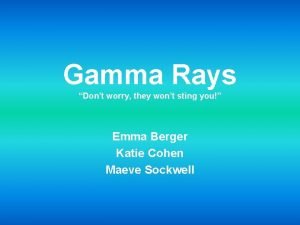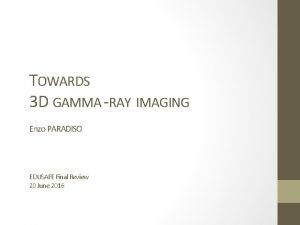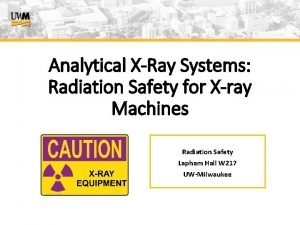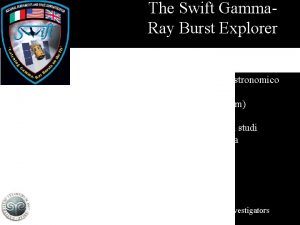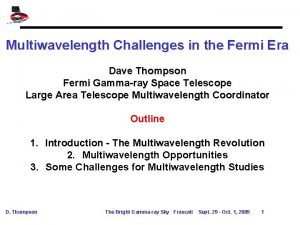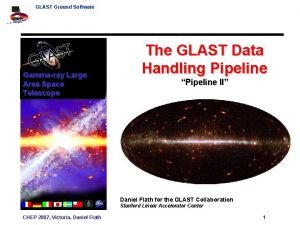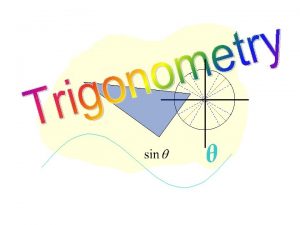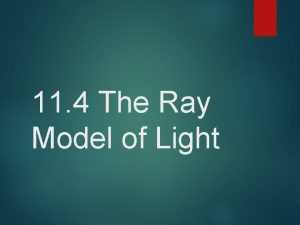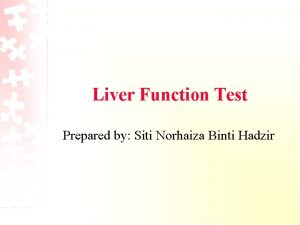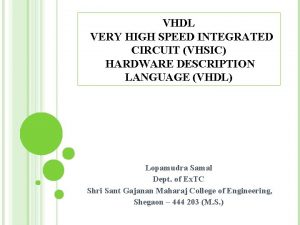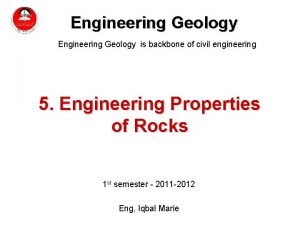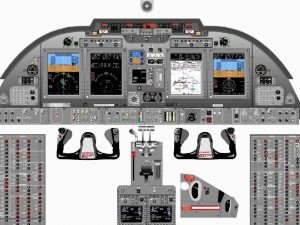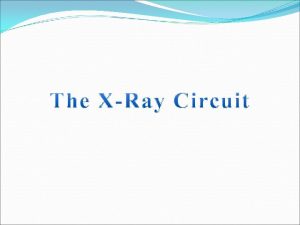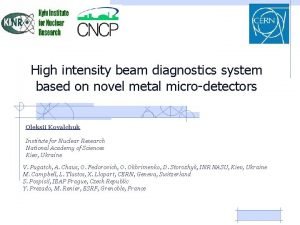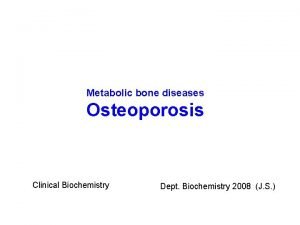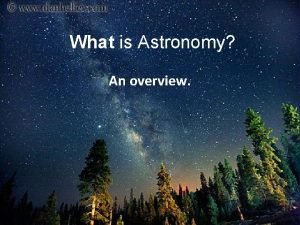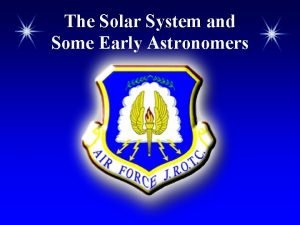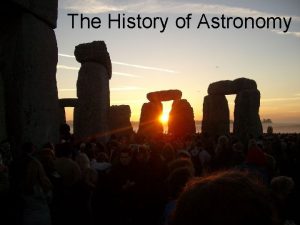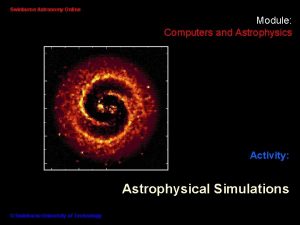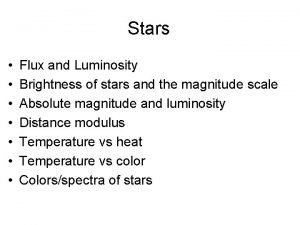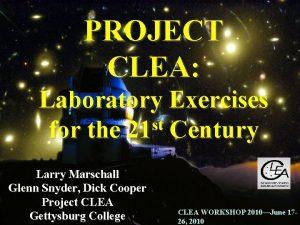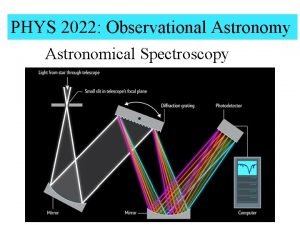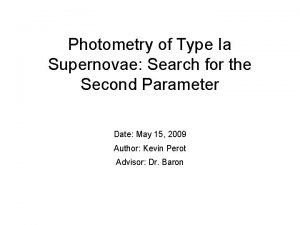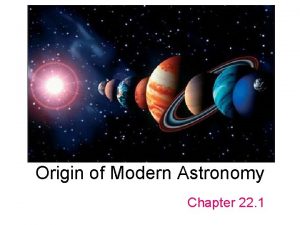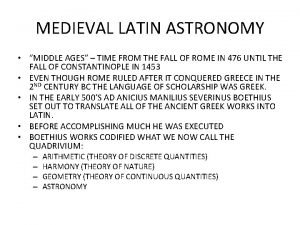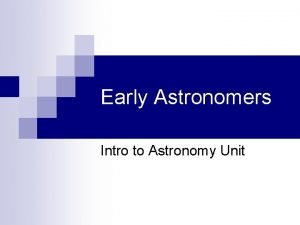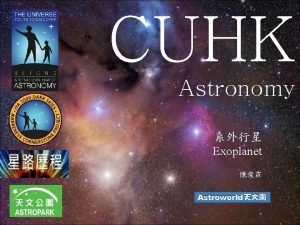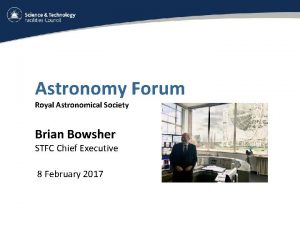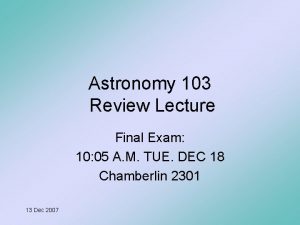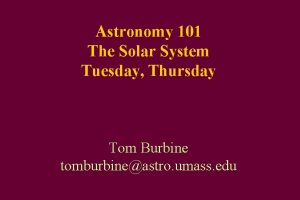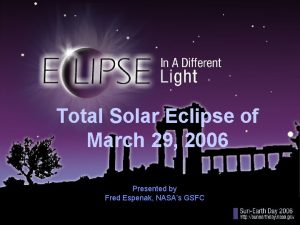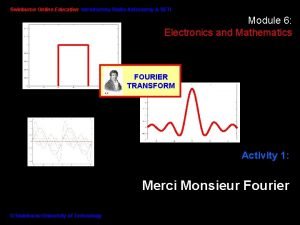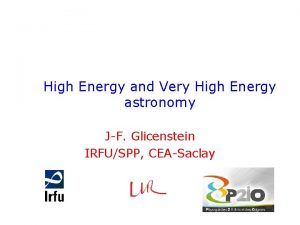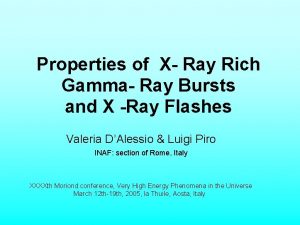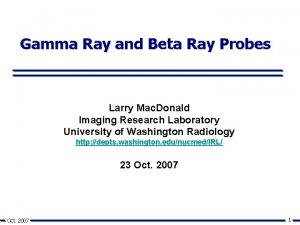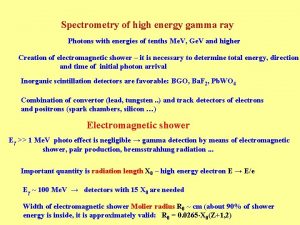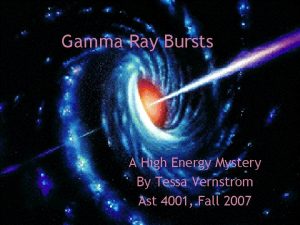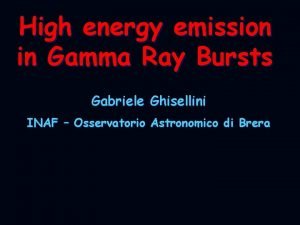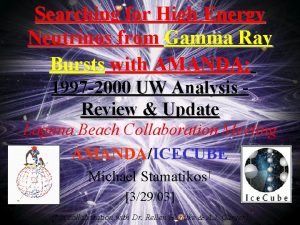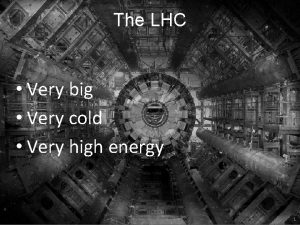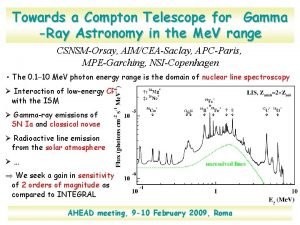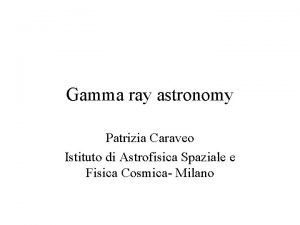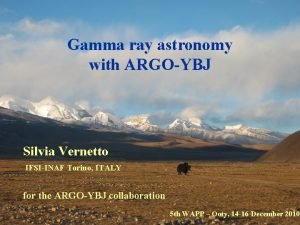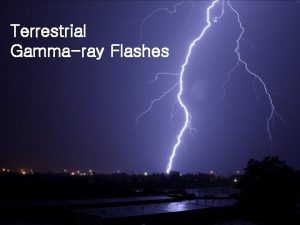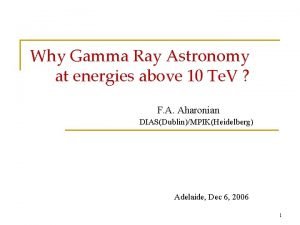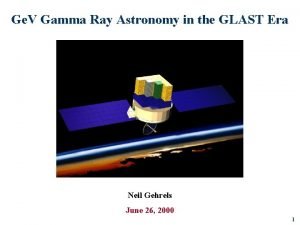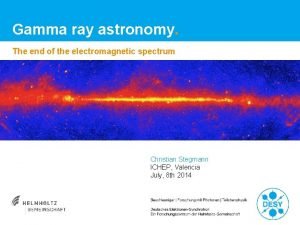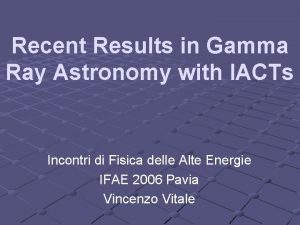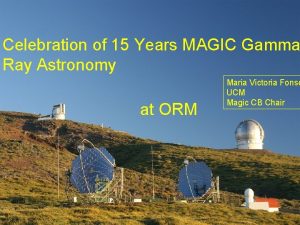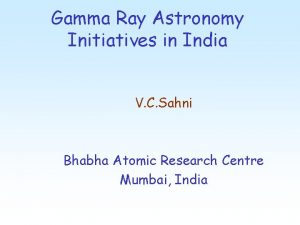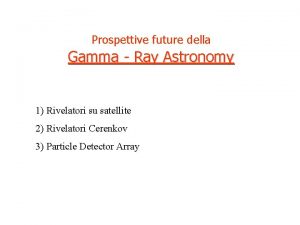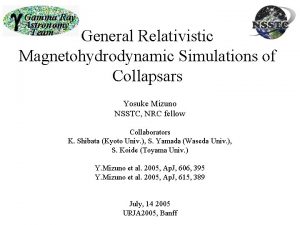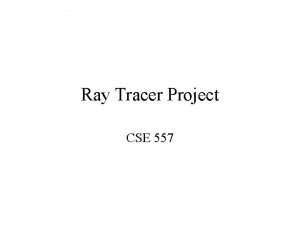Very High Energy Gamma Ray Astronomy A new
































![Periastron Flux >380 Ge. V [cm-2 s-1] The PSR B 1259 -63 field of Periastron Flux >380 Ge. V [cm-2 s-1] The PSR B 1259 -63 field of](https://slidetodoc.com/presentation_image/3ae6ccfe82189d954573dc7dde3008b7/image-33.jpg)





















- Slides: 54

Very High Energy Gamma Ray Astronomy - A new window to the Universe – Christian Stegmann University of Erlangen-Nuremberg Humboldt University Berlin XXV Physics in Collisions, Prague 2005

The sky at energies of 1 e. V

Active Galactic Nuclei The Galactic Centre The sky at energies of 1 Te. V Terra Incognita The Crab nebula The strongest Te. V source Flux ~1 Photon/km 2/s Surprises and progress in 2004/2005 Supernovae Pulsars, unknown sources, scans … The accelerators of Cosmic rays? Status PIC 2004 Stärkste Quelle 1 photon km-2 s-1

The main players Imaging Atmospheric Cherenkov Telescopes

Detection of gamma-rays via the Cherenkov light from air showers Photon Particle shower ~ 10 km Ch er en ko v lig ht ~ 1 o ~ 120 m Intensity shower energy Image orientation shower direction Image shape primary particle

Stereoscopic Observation Technique Source position

Cherenkov Telescopes Worldwide Veritas artist view H. E. S. S. MAGIC CANGAROO III

Cherenkov Telescopes Worldwide Status # Tel Mirror (m 2) F. o. V (o ) Energy threshold (Ge. V) MAGIC Data taking 08/2004 1 239 3. 5 30 -50 H. E. S. S. Data taking 12/2003 4 108 5 100 CANGAROO III Data taking 03/2004 4 57 4 ~250 Veritas Start 10/2006 Prototyp running 4 100 4. 5 ~100

My personal highlights in 2004

My personal highlights in 2004 The supernova remnant RX J 1713. 7 -3946 H. E. S. S. Nature 432, 75 (2004) First ever astronomical gamma-ray image

My personal highlights in 2004 H. E. S. S. : First sensitive scan of the inner Galaxy Scan region

My personal highlights in 2004 8 new sources! Science 307, 1938 (2005)

Galactic Sources

Crab Nebula Veritas • Supernova from 1054 A. D. • 6500 Ly distance • 33 ms pulsar • Plerion • relativistic electron plasma heated by the central pulsar 2. 6 gammas/minute 10. 1 sigma/sqrt(time in hours) VLT, optical The standard candle of gamma-ray astronomy Seen by all instruments

Krebs. Nebula Nebel Crab Synchrotron radiation Electron Inverse Compton scattering Electron

Krebs. Nebula Nebel Crab Synchrotron radiation Electron Inverse Compton scattering Electron H. E. S. S. preliminary

Shell type supernova remnants Cas A, Chandra, Röntgen

Cosmic Ray Accelerators? • Why supernova remnants? – large energy release (d. E/dt)SN = 10. (d. E/dt)CR – acceleration in shock waves – element composition of Cosmic Rays • Why gamma-rays? – Electrons: -radiation via IC – Hadrons: 0 – pointing • Search strategies – non-thermal X-rays – scans Cas A, Chandra, X-rays

The supernova remnant RX J 1713. 7 -3946 ROSAT (ke. V) Age ~1500 years CANGAROO II (Te. V) Point source

H. E. S. S. 2004 33 h with 4 Telescopes 210 Ge. V threshold point source

H. E. S. S. 2004 33 h with 4 Telescopes 210 Ge. V threshold point source

Energy spectrum preliminary One-zone model Power law d. N/d. E = K E-α Spectral index: α = 2. 2

Implications Unambiguous proof that supernova shock waves are cosmic accelerators; they accelerate particles to O(100 Te. V) But are they the sources of (nucleonic) cosmic rays ? Is the kinetic energy released in the explosion converted to cosmic-ray energy with O(10%) efficiency ?

Electron or hadron accelerator? radio infrared visible light E 2 d. N/d. E Stars X-rays VHE -rays B Dust Cosmic electron accelerators Synchrotron radiation ln(E) Cosmic proton accelerators B Inverse Compton Bremsstrahlung

Electron accelerator radio X-rays VHE -rays E 2 d. N/d. E (erg cm-2 s-1) F. A. Aharonian Injection spectrum: “low” target magnetic densityfield power law with cutoff log(E/e. V)

Electron accelerator X-rays E 2 d. N/d. E (erg cm-2 s-1) radio log(E/e. V) VHE -rays

Spatially resolved spectra H. E. S. S. preliminary X-ray photon index G. Cassam-Chenaï A&A 427, 199 (2004) Te. V photon index

Proton accelerator F. A. Aharonian • Continuous proton injection over 1000 years • Injection spectrum: power law, index ~2 • Different cutoff shapes

Vela Junior ROSAT H. E. S. S. 2005 2004 preliminary ~3 hh ~10 Power law index 2. 1 (see also CANGAROO Ap. J, 619, L 163 -L 165 (2005) )

HESS J 1834 -087 HESS J 1804 -216 HESS J 1640 -465 More possible SNR associations • Separation of electron and hardon component • Multi-wavelength observations • Correlation with molecular clouds “Beam width”

The binary system PSR B 1259 -63/SS 2883 The first variable galactic Te. V-source

The binary system PSR B 1259 -63 / SS 2883 Periastron 7. March 2004 Be Star 10 M Discovery Complex (March interaction 2004): between pulsar and star during periastron 48 ms Pulsar 3. 4 y period
![Periastron Flux 380 Ge V cm2 s1 The PSR B 1259 63 field of Periastron Flux >380 Ge. V [cm-2 s-1] The PSR B 1259 -63 field of](https://slidetodoc.com/presentation_image/3ae6ccfe82189d954573dc7dde3008b7/image-33.jpg)
Periastron Flux >380 Ge. V [cm-2 s-1] The PSR B 1259 -63 field of view H. E. S. S. Feb. 04 March 04 Apr. /May 04

The PSR B 1259 -63 field of view HESS J 1303 -631 What are these “dark” accelerators? Source HESS J 1303 -631 • is extended • has constant flux • no association with radio or X-ray source! other unknown sources: Feb. 04 März 04 Te. V J 2032+4130 (HEGRA) HESS J 1616 -508 Apr. /Mai 04

The Galactic Centre

The Galactic Centre Chandra GC survey NASA/UMass/D. Wang et al. NASA/UMass/D. Wang CANGAROO (80%) H. E. S. S. (95%) Whipple (95%) Contours from Hooper et al. 2004 Seen by CANGAROO Whipple/Veritas H. E. S. S.

Das Galaktische Zentrum H. E. S. S. 2004 50 h with 4 telescopes preliminary HESS J 1745 -290 35 significance

Sagittarius A H. E. S. S. 2004 preliminary Sgr A East SNR Sgr A* Systematic pointing error Radio Te. V H. E. S. S.

Sagittarius A H. E. S. S. 2004 preliminary Point-like core Extended tail Te. V H. E. S. S.

Gamma ray spectrum • Power law, index 2. 3 • No significant variability Preliminary

HESS J 1745 -290 Either Sgr A*. . . Supermassive (M 3. 106 M ) rotating black hole in a magnetic field huge electromotive force (e. m. f. ) • able to accelerate protons up to 1018 e. V ( 0 ) • or electrons ( -rays via IC) . . . or Sgr A East 3‘ Sgr A* Sgr A East • 10000 years old supernova • covers Sgr A* • Fermi-acceleration of Cosmic Rays in expanding shock wave or …

… Dark matter annihilation ? H. E. S. S. 2004 Preliminary For pure DM origin • rather large mass • large x-section or density • unusual spectrum or superposition of spectra 20 Te. V Neutralino 20 Te. V Kaluza Klein particle

Extragalactic Sources Active Galactic Nuclei

Active Galactic Nuclei • Supermassive black holes, M 109 M • Accretion disc with relativistic jet Blazar-Typ: Jet towards Earth • Doppler-boost of emission spectra Te. V -radiation

Active Galactic Nuclei e+ e- d. N/d. E Absorption in extragalactic background light (Infrared) (Te. V) + (IR) e+e- E Physics of compact objects and relativistic jets and … d. N/d. E E Study of the infrared background light Cosmology

-ray horizon Blanch & Martinez 2004 Different models for the extragalactic background light (EBL) simulated Measurements H. E. S. S. , CANGAROO, Veritas MAGIC

AGN Physics e. g. Mkn 421 (z=0. 031) Emission spectra – Synchrotron-Self-Compton – Flares – Intrinsic Cut-offs F [erg cm-2 s-1] Mkn 421 multi-wavelength spectra Konopelko et al. Ap. J 597 (2003) 851 Ecut [Te. V] Flux [10 -11 cm-2 s-1] Many sources at large z [Hz] Many sources at the same. Mkn z 421 Cut-offs Mkn 421 flares 2004 H. E. S. S. 2004 MJD H. E. S. S. 2004 Flux(E>2 Te. V) [cm-2 s-1]

Simultaneous Observations e. g. MAGIC & H. E. S. S. Simultaneous observation of a large energy range e. g. Mkn 421 flare in 2003/2004 MAGIC H. E. S. S. Index = 2. 1± 0. 3 ECut = 3. 1± 0. 5± 0. 9 Te. V H. E. S. S.

-ray horizon PKS 2155 -304 H. E. S. S. Mrk 421 (H. E. S. S. , MAGIC) Mrk 501 1 ES 1959+650 PKS 2155 -304 (MAGIC) (H. E. S. S. ) H 1426+428 ground state N. Tonello, T 202. 1

AGN limits • 19 BL Lacs and other AGNs H. E. S. S. • z between 0. 002 and 0. 3 Mkn 501 Significance • 1 -5 h obs. time • limits 1 -3% of Crab flux

Upgrades

Upgrade MAGIC II • 2 nd telescope same as Magic I (stereoscopy) • Photosensors with high QE • Ready in 2006 H. E. S. S. II • Improved sensitvity • Reduced threshold O(20 Ge. V) • Ready 2007 -2008

Highlights 2004/2005 H. E. S. S. An unknown source First image of a Te. V source First variable galactic source H. E. S. S. The weakest Te. V source The galactic centre The largest Te. V source The Crab seen by The last year: Big successes and discoveries Veritas H. E. S. S. scan 2004: 8 new sources Crab-spectrum above 100 Ge. V

 Learning astronomy by doing astronomy activity 1 answers
Learning astronomy by doing astronomy activity 1 answers Learning astronomy by doing astronomy
Learning astronomy by doing astronomy Learning astronomy by doing astronomy activity 1 answers
Learning astronomy by doing astronomy activity 1 answers Discovery of gamma rays
Discovery of gamma rays Gamma ray
Gamma ray Who discovered xrays
Who discovered xrays Swift gamma ray burst explorer
Swift gamma ray burst explorer Gamma ray sky
Gamma ray sky Gamma-ray
Gamma-ray Espectro eletromagnético
Espectro eletromagnético Gamma ray burst
Gamma ray burst High point astronomy
High point astronomy Very bad to very good scale
Very bad to very good scale Scientific notation rules
Scientific notation rules Few fewfewf
Few fewfewf Receiving table/area
Receiving table/area Quantifiers for milk
Quantifiers for milk Sin and cos in quadrants
Sin and cos in quadrants Ray ray model
Ray ray model Ray tracing and ray casting
Ray tracing and ray casting Vanden bergh reaction
Vanden bergh reaction Energy energy transfer and general energy analysis
Energy energy transfer and general energy analysis Energy energy transfer and general energy analysis
Energy energy transfer and general energy analysis Vhsic
Vhsic Low mass star life cycle
Low mass star life cycle Which rock possesses very high compressive strength?
Which rock possesses very high compressive strength? Very high frequency omnidirectional range
Very high frequency omnidirectional range What is a falling load generator
What is a falling load generator High intensity x-ray beam machine
High intensity x-ray beam machine A psychologist who classifies an individual's personality
A psychologist who classifies an individual's personality Dual energy x ray absorptiometry (dexa)
Dual energy x ray absorptiometry (dexa) Osteoporosis t score
Osteoporosis t score Ray creates an energy transfer diagram for a hair dryer
Ray creates an energy transfer diagram for a hair dryer What is astronomy
What is astronomy Claudius ptolemy astronomy contributions
Claudius ptolemy astronomy contributions Aristotle astronomy
Aristotle astronomy Swinburne astronomy online
Swinburne astronomy online Mizar luminosity
Mizar luminosity Luminosity and magnitude
Luminosity and magnitude Vireo astronomy
Vireo astronomy Astronomy questions and answers multiple choice
Astronomy questions and answers multiple choice Phys2022
Phys2022 Distance ladder astronomy
Distance ladder astronomy Origin of modern astronomy
Origin of modern astronomy Astronomy in the middle ages
Astronomy in the middle ages Astronomy definition earth science
Astronomy definition earth science Claudius ptolemy astronomy contributions
Claudius ptolemy astronomy contributions Cuhk astronomy
Cuhk astronomy Atronomy vs astrology
Atronomy vs astrology Astronomy forum uk
Astronomy forum uk Astronomy 103 final exam
Astronomy 103 final exam Astronomy 101 formulas
Astronomy 101 formulas Astronomy science fair projects
Astronomy science fair projects Astronomy picture of the day march 29 2006
Astronomy picture of the day march 29 2006 Time domain astronomy
Time domain astronomy



